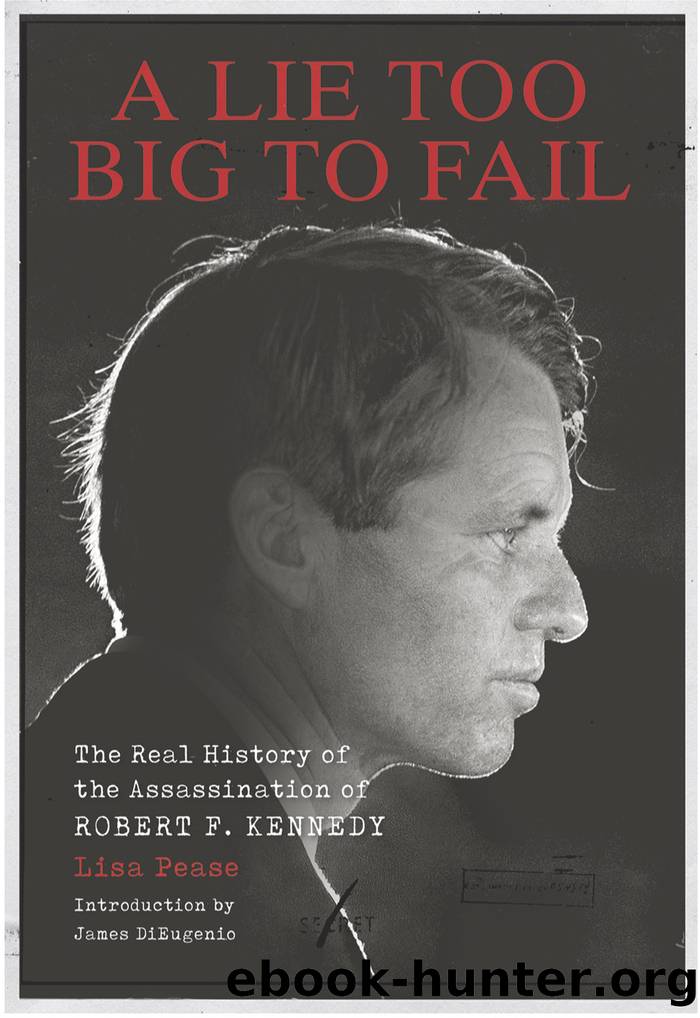A Lie Too Big to Fail_The Real History of the Assassination of Robert F. Kennedy by Lisa Pease

Author:Lisa Pease [Pease, Lisa]
Language: eng
Format: epub
Tags: Political Science, History & Theory, History, United States, 20th Century, True Crime, Murder, General, Privacy & Surveillance, Language Arts & Disciplines, Journalism
ISBN: 1627310703
Google: uCRyDwAAQBAJ
Amazon: B07J5RSBN1
Publisher: Feral House
Published: 2018-12-18T00:00:00+00:00
TOO MANY HOLES
âPolice officers framed innocent individuals by planting evidence and committing perjury to gain convictions. Nothing is more inimical to the rule of law than police officers, sworn to uphold the law, flouting it and using their authority to convict innocent people. Innocent men and women pleaded guilty to crimes they did not commit and were convicted by juries because of the fabricated cases against them.â
EVERY TIME I SIT IN A COURTROOM FOR JURY DUTY, THE JUDGE admonishes us not to dismiss circumstantial evidence, but to treat it the same way we would direct evidence. Several judges have given an example of seeing someone come in from the outside carrying an umbrella and wearing a wet raincoat. It would be reasonable to assume the person had come in from the rain. While it was possible that the person had jumped, fully clothed, into a shower to construct an elaborate ruse, without any additional evidence, the reasonable conclusion was that the person had just come in from the rain. You didnât have âproofâ that the person had been out in the rain, but you could make a logical deduction based on the evidence presented.
In this case, ask yourself if it is reasonable to believe every witness to evidence of conspiracy was simply mistaken? That not one of the additional bullet holes reported in the pantry were actually bullet holes? That although the shooter had to have been behind Kennedy and all the witnesses who saw both Kennedy and Sirhan during the shooting put them from three to six feet apart, all the witnesses were mistaken? Itâs possible that all the other witnesses were randomly mistaken all in the same direction, but it is not reasonable.
Each judge has also admonished the would-be jurors that we were to decide for ourselves what the facts of the case were. We were to examine the evidence and testimony presented to determine the facts of the case. The judge stressed it was not the number or quality of witnesses that mattered. âIf you believe a single witness,â one judge told my October 2016 jury pool, âthen you can consider that a fact. You donât judge the evidence by the number of witnesses that report the same thing. If you believe even one of them, that is enough for you to consider their statement a fact.â Witnesses never have perfect recall of a crime. But in the pantry, enough of them told a consistent picture that what happened starts to become clear. Each judge also made clear that a personâs position in life does not matter and should not even enter our minds. A criminal could be telling the truth. A policeman could be lying.
Download
This site does not store any files on its server. We only index and link to content provided by other sites. Please contact the content providers to delete copyright contents if any and email us, we'll remove relevant links or contents immediately.
Asking the Right Questions: A Guide to Critical Thinking by M. Neil Browne & Stuart M. Keeley(5649)
Autoboyography by Christina Lauren(5184)
Eat That Frog! by Brian Tracy(4436)
Dialogue by Robert McKee(4323)
Sticky Fingers by Joe Hagan(4103)
Journeys Out of the Body by Robert Monroe(3572)
Annapurna by Maurice Herzog(3424)
Full Circle by Michael Palin(3389)
Schaum's Quick Guide to Writing Great Short Stories by Margaret Lucke(3321)
Elements of Style 2017 by Richard De A'Morelli(3307)
The Art of Dramatic Writing: Its Basis in the Creative Interpretation of Human Motives by Egri Lajos(3017)
Atlas Obscura by Joshua Foer(2900)
The Diviners by Libba Bray(2887)
Why I Write by George Orwell(2877)
In Patagonia by Bruce Chatwin(2876)
The Fight by Norman Mailer(2848)
The Mental Game of Writing: How to Overcome Obstacles, Stay Creative and Productive, and Free Your Mind for Success by James Scott Bell(2845)
Venice by Jan Morris(2526)
The Elements of Style by William Strunk and E. B. White(2442)
